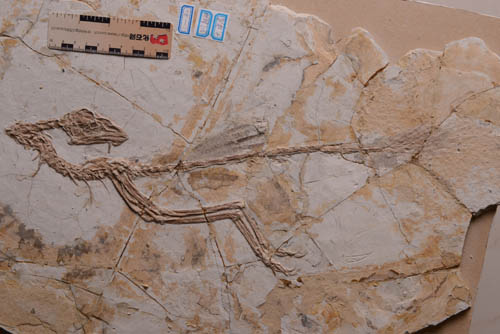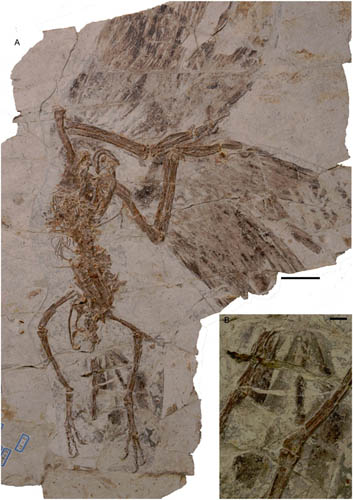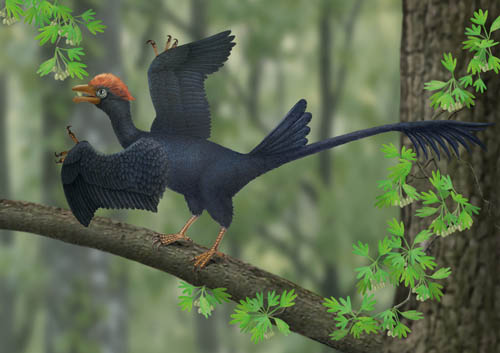| Location: Home > Research > Research Progress |
| Early Cretaceous Bird With Unique “Two-tail” Plumage Found in China |
|
A bird that lived 125 million years ago in what is today Western Liaoning of Northeast China had a unique “two-tail” plumage, according to a study published October 07 in the early edition of the Proceedings of the National Academy of Sciences. The new specimens indicate a previously unrecognized degree of diversity in the tail plumage configurations of Mesozoic birds and demonstrate that tail evolution did not follow a simple path from the “frond-like” arrangement seen in Archaeopteryx and some derived nonavian theropods to the “fan-like” arrangement seen in modern birds. First described more than a decade ago, the Early Cretaceous bird Jeholornis was previously only known to have a distally restricted ornamental frond of tail feathers. Researchers from the Institute of Vertebrate Paleontology and Paleoanthropology (IVPP), Chinese Academy of Sciences, Linyi University and Tianyu Museum of Nature in Shandong, China, and Museo Argentino de Ciencias Naturales in Buenos Aires, Argentina, analyzed the bird Jeholornis and observed a previously unrecognized fan-shaped tract of feathers situated dorsal to the proximal caudal vertebrae. The find makes Jeholornis unique, as it combines an ancestral long tail with a fan of feathers at its base that resembles the tail feathers of modern birds, said Dr. ZHOU Zhonghe of the IVPP, corresponding author and project designer. Zhou's team examined 11 Jeholornis fossils with preserved tail feathers and found that four had both aerofoil-like fans up to 10 centimetres long at the base of their tail and frond-like tufts of feathers at the tips. A further four just had the aerofoils, and two had just the frond-like tufts, while one had traces of feathers that could not be identified. A key question is the purpose of the two groups of feathers. “The position and morphology of these feathers is reminiscent of the specialized upper tail coverts observed in males of some sexually dimorphic neornithines. As in the neornithine tail, the unique ‘two-tail’ plumage in Jeholornis probably evolved as the result of complex interactions between natural and sexual selective pressures and served both aerodynamic and ornamental functions”, said lead author Dr. Jingmai O’Connor of the IVPP, “We suggest that the proximal fan would have helped to streamline the body and reduce drag whereas the distal frond was primarily ornamental. Jeholornis reveals that tail evolution was complex and not a simple progression from frond to fan.” The resemblance of the fan to the tails of modern birds suggests "it would be a reasonably good pitch and roll generator" in flight, said Michael Habib of the University of Southern California in Los Angeles, who was not involved in the study. But he doubts it could have done much for yaw–motion about the vertical axis. However, Stephen Gatesy of Brown University in Providence, Rhode Island, warns that we need to know how the feathers were attached to the body before we can tell how well they aided flight. The research was supported by the National Basic Research Program of China (973 Program), National Natural Science Foundation of China and the Chinese Academy of Sciences.  Fig.1 Tail feathers in Jeholornis preserving both the proximal fan and distal frond. (Image by ZHOU Zhonghe)  Fig.2 The proximal tail fan in Jeholornis forming a horizontally oriented fan, or aerofoil. (A) Full slab, scale bar 5 cm; (B) Close up of the proximal fan, scale bar 1 cm. (Image by ZHOU Zhonghe)  Fig.3 This artist's reconstruction of Jeholornis shows the bird's long 'distal' tail, thought to be an ornamental structure, along with a newly discovered fan like tail thought to aid flight stabilization. (Image by SHI Aijuan) |